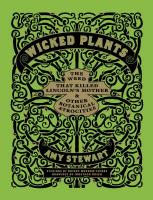
 This small book of dark and deadly facts from the world of plants is intertwined with literary works involving poisonous botanicals. Not a work of scholarly research, it is light reading for gardeners and crime readers alike. The book mentions common plants living in our houses together with exotic species. The book includes famous historical characters and their encounters and misfortunes with poisonous plants. The mother of Abraham Lincoln had an unfortunate encounter with a household poisonous plant. While desperately low on food, the members of the Lewis and Clark expedition consumed a poisonous plant mistaken for an herb. Other characters written about in this book are Charles Dickens, Charlotte Bronte, William Burroughs and Allen Ginsberg. Some stories and historical characters in this book date back 5,000 years. It contains writings of Pliny the Elder, stories from Greek mythology as well as articles from medical journals. Some plants are so important that humans went to war over them. Opium was mentioned already in Homer’s Odyssey. The book describes plants used by early physicians and plants used by women to dilate their pupils to make their eyes beautiful. There is a plant which, when consumed people develop pale skin which erupts with blister when exposed to then sun , causing sleepless nights, which possibly inspired European myths of vampirism in Bram Stoker's Dracula. Socrates, after being convicted of corrupting the youth, was sentenced to death by drinking poison from hemlock, a plant from the carrot family. Incas in Peru produced the coca plant flavoring in coca-cola in its times. We are told about the discovery of Absinthe, tonic water and quinine, all derived from plants. The book describes a story of Jamestown weed, which helped the patriots to conquer the British soldiers who took it for nourishment. Ergot, a toxic fungus that infects rye or wheat, results in "dancing mania" hysteria and hallucinations are all signs of ergot poisoning These symptoms could be an easy explanation of the events of the winter 1691 in Salem, Massachusetts. It was a burr from a plant found in dog’s fur of a Swiss engineer that brought us Velcro. In 1960 many plants were tested for their anti-cancer properties. There was also the famous KGB "umbrella murder" cases involving Castor Bean poisoning. Super-hot chili peppers are still used in the rituals of various native tribes. This is a fast read full of many fascinating stories where lives were effected or ended by poisonous plants. One does not have to have a green thumb or be a gardener to enjoy this book. Extensive bibliography of related books. List of botanical gardens all over the world featuring poisonous plants.
This small book of dark and deadly facts from the world of plants is intertwined with literary works involving poisonous botanicals. Not a work of scholarly research, it is light reading for gardeners and crime readers alike. The book mentions common plants living in our houses together with exotic species. The book includes famous historical characters and their encounters and misfortunes with poisonous plants. The mother of Abraham Lincoln had an unfortunate encounter with a household poisonous plant. While desperately low on food, the members of the Lewis and Clark expedition consumed a poisonous plant mistaken for an herb. Other characters written about in this book are Charles Dickens, Charlotte Bronte, William Burroughs and Allen Ginsberg. Some stories and historical characters in this book date back 5,000 years. It contains writings of Pliny the Elder, stories from Greek mythology as well as articles from medical journals. Some plants are so important that humans went to war over them. Opium was mentioned already in Homer’s Odyssey. The book describes plants used by early physicians and plants used by women to dilate their pupils to make their eyes beautiful. There is a plant which, when consumed people develop pale skin which erupts with blister when exposed to then sun , causing sleepless nights, which possibly inspired European myths of vampirism in Bram Stoker's Dracula. Socrates, after being convicted of corrupting the youth, was sentenced to death by drinking poison from hemlock, a plant from the carrot family. Incas in Peru produced the coca plant flavoring in coca-cola in its times. We are told about the discovery of Absinthe, tonic water and quinine, all derived from plants. The book describes a story of Jamestown weed, which helped the patriots to conquer the British soldiers who took it for nourishment. Ergot, a toxic fungus that infects rye or wheat, results in "dancing mania" hysteria and hallucinations are all signs of ergot poisoning These symptoms could be an easy explanation of the events of the winter 1691 in Salem, Massachusetts. It was a burr from a plant found in dog’s fur of a Swiss engineer that brought us Velcro. In 1960 many plants were tested for their anti-cancer properties. There was also the famous KGB "umbrella murder" cases involving Castor Bean poisoning. Super-hot chili peppers are still used in the rituals of various native tribes. This is a fast read full of many fascinating stories where lives were effected or ended by poisonous plants. One does not have to have a green thumb or be a gardener to enjoy this book. Extensive bibliography of related books. List of botanical gardens all over the world featuring poisonous plants.
